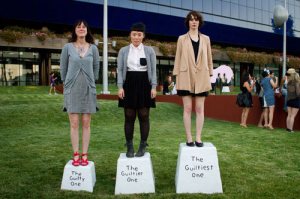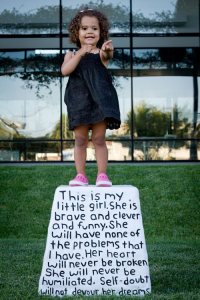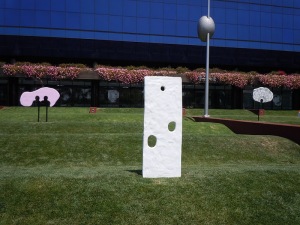“Miranda July at The Pacific Design Center,” Artillery Magazine, Nov./Dec. 2011. Vol. 6 Issue 2. 65-66. 2011
We call bad public art “plop art” for a reason. Like giant metal turds, or hulking bronze zits dotting urban vistas, bad public art often takes the form of pompous engorged renditions of famous artists’ work, or worse, fiberglass renditions of city mascots, or bronze memorial statues of dead white dudes. In each case, the public often engages these monstrosities by making fun of them, photographing friends picking bronze noses, or applying makeup a’ la Dazed and Confused. And, of course, ask any child or bored adolescent and they will tell you, public art sporting DO NOT TOUCH signs should be outlawed, melted-down, and turned into swing-sets. Miranda July’s Eleven Heavy Things, a collection of sculptures outside the Pacific Design Center, takes public art behemoths to task, closing the distance between the viewer and the artwork, while leaving room for the multiple forms of communication that may exist in between.
July’s most successful works on the PDC lawn employ text as a way to direct viewers towards certain actions. One simple white pillar, approx. 8 ft. tall, with a small hole in its center surrounded by hand-drawn black text, reads, “This is not the first hole my finger has been in; nor will it be the last.” As a work that specifically calls attention to the not-so-hidden sexual undertones of any upright phallus, and the previously mentioned naughty gestures apropos to adolescent interactions with public sculpture, this particular work resonates as both hilarious and subversive. If only this monument to peculiar orifices was translated into more languages, and installed near the Washington Monument, or a sculpture of, say, Dick Nixon, July’s implicit critique of poking through symbolic power would be made even more manifest.

These text-employing works find their formal counterparts in cloud-like headpieces designed to frame visitors’ own heads. While such formal peculiarities work like predictable public art – providing colorful shapes to be seen from a distance, when experienced in person, they perform differently than the other text-laden works, providing costuming instead of a prompt. Of all July’s cloud-like forms, one patterned in faux Burberry plaid makes a funny reference to the work’s posh surroundings, as if telling us what is really on the minds of the elite consumers who frequent the PDC.

What makes July’s eleven awkward sculptures particularly enjoyable is that they are each designed to be part of a photo op, implicitly requiring both an actor and a spectator in order to achieve a desired effect. One views the work twice: once in person, and then again on the internet, a viewing experience perfectly suited for the Facebook generation, where every action must be photographed and made public in order to be remembered, and concretized as real.
In not taking its role as public art too seriously, July’s work is able to make a very serious proposition about how we might conceive public art as something that must take its audience’s body and photographic agency into account. Her work may not be the weightiest of propositions, but it certainly creates a lasting and multivalent impact. Just Google the work to see what I mean.
©2024 Tucker Neel. All rights reserved.